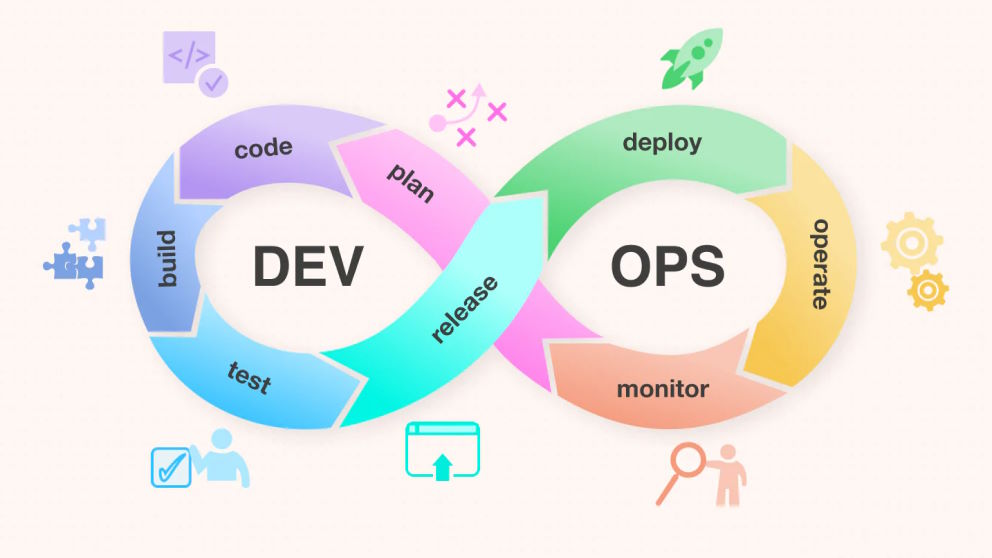How to Execute a Successful DevOps Implementation Plan

Content Map
More chaptersDevOps (a mixture of the terms ‘development’ and ‘operations’) is a unique workflow, one where different contributors from different departments – albeit all working on the same project – collaborate on every aspect of a project.
In the case of software development, this applies to stages like conceptualizing, designing, testing, and post-deployment support. This approach is quite different from traditional software development. Back in the day, individual team members and departments would work separately, independent of one another, each focused on their respective roles and tasks – with little regard to how their contributions would impact the overall project.
Over the years, though, the DevOps methodology has become the dominant approach to developing software, being used by small and large companies across many industries to deliver a larger volume of higher-quality products. In this article, you’ll learn what DevOps is, how it works, its advantages and disadvantages, and how to incorporate DevOps implementation into your project.
What Is DevOps?

DevOps is a development methodology that involves having all team members across multiple departments contribute to different aspects of a software application. The purpose of DevOps is to eliminate siloed thinking, foster a culture of ongoing feedback and collaboration (throughout each stage of development), detect bugs and issues early, and provide ongoing post-deployment support. Furthermore, DevOps has all team members assume (close to) equal responsibility for different aspects of a product, giving everyone a greater incentive to work together and release a high-quality product.
DevOps involves using various tools and technology to make this methodology work. However, DevOps alone is not a “tool” but an overarching cultural shift designed to change the way people work and interact with each other. DevOps implementation requires spending considerable time and resources creating a viable plan, performing risk management, assigning roles and responsibilities, and much more. With the right plan, software development companies (and clients) enjoy the benefits of the DevOps methodology, with all involved on the same page – working towards the same unified goal.
How Does DevOps Work?

DevOps works by making various significant changes to the way a software development team works. This involves redefining the roles that employees assume, establishing systems for ongoing feedback and collaboration, prioritizing testing, security, and quality assurance at each stage of the project, and much more.
Moreover, DevOps implementation involves choosing the right tools and technology to ensure the workflow goes smoothly. Examples of DevOps tools include software for project management, real-time collaboration, infrastructure automation tools, monitoring tools, and continuous feedback tools. Each of these software applications may be designed to perform a specific function, as is the case for monitoring tools, which are designed to help specific team members identify and resolve system issues early.
Automation is one must-have component of the DevOps methodology. It involves the use of automation to streamline tasks previously performed by manual means. Automated software testing tools can help DevOps teams automatically perform different tests, such as unit testing, integration testing, and functionality testing. Automated integration testing tools can help development teams determine if two or more modules (or components) are compatible with each other. Such tools can also help reveal if the inclusion of a specific module is causing problems elsewhere for the software.
What Are the Advantages and Disadvantages of DevOps Implementations?
There are many advantages and disadvantages of DevOps to consider.
Do you want to be more involved in the process? Receiving continuous feedback and progress updates, allowing you to provide your input, offer suggestions, and rectify issues (as they occur)? Fortunately, the DevOps methodology offers you these benefits and more.
However, it is important to consider the potential downsides as well. Any good development team will be upfront and honest about this, and they will work with you to formulate a plan to prevent those issues from inhibiting progress on your project.
Let’s take a closer look at the DevOps methodology, both the good and bad.
Advantages of DevOps

Accelerate Time to Development
With the right plan and approach, the DevOps methodology has the potential to significantly accelerate your time to market. This is because, under DevOps, dedicated software teams work on different aspects of the project in sprints, where each sprint represents a specific project milestone to achieve. After completing each sprint, the team reflects on the work they completed for that sprint, identifying what worked, what didn’t work, and what could be improved for next time.
As a result, software development teams with many years of DevOps experience have often fine-tuned their sprints to the point where they get faster and faster at completing projects that they have done before. For example, if a team has several years of experience in mobile application development, then there is a good chance that the team has heavily optimized their sprints to the point where they can complete certain sprints faster than anyone else.
Eliminate Siloed Thinking and Promote Collaboration
One of the major setbacks of the waterfall approach, the traditional software development approach, is that teams were often split into individual departments, often isolated, focused on their own department-specific goals and outcomes, with little regard for how their contributions influenced other aspects of the final product.
Fortunately, the DevOps methodology changed that. Under DevOps, different departments (under the same team) operate as a cohesive unit, working together to understand each other’s contribution to a project. By doing so, teams can share ideas, think outside the box, identify and rectify issues early (before they manifest later on), and make decisions that benefit not just the final product but also help streamline the workflow for everyone else.
Embrace Automated Tools
Automation is a fantastic way to reduce (or even eliminate) repetitive, mundane, and (potentially even) dangerous manual labor. The DevOps methodology is a strong proponent of automation, encouraging developers to use automated tools and software to perform certain types of coding, testing, and quality assurance tasks.
Aside from streamlining workflows and accelerating time to market, automation also helps development teams identify and resolve issues sooner, as testing is a primary focus from the very beginning – not left until the last minute, just before launching.
Disadvantages of DevOps
Poorly Planned DevOps Strategies
It’s important to understand what DevOps is; it is not a set of tools and software; it’s a fundamental shift in the way development teams work together.
For this reason, there is always the chance a DevOps strategy could fail. This can happen if the strategy is not the right fit for the project, people get confused about their duties and responsibilities, or leadership fails to monitor progress and fine-tune the strategy to deliver better results.
DevOps is not something you just set and forget about. It requires continuous monitoring and fine-tuning to pull off successfully. That’s why at Orient Software, we assign dedicated project managers to each DevOps project we accept. The project manager is accountable for overseeing every aspect of a project, from conceptualizing and designing to programming and testing, plus more. They ensure the team is on track, understands their roles for a given project, and is unified in achieving mutually beneficial goals.
May Confuse and Frustrate Development Teams
A DevOps strategy is only as good as the people who contribute to the cause. If there is any confusion as to why certain decisions are made, who is supposed to be doing what, and what the overarching goals are, then problems occur.
To remedy this situation, software development teams should have an in-depth understanding of their roles, duties and responsibilities, and expected outcomes. Each team member should also be aware of what the other departments are doing and how their contributions will influence other people’s work.
For example, software developers and programmers should consider the security implementations of the code they write, ensuring the core is secure and free of any vulnerabilities. This, in turn, could result in far fewer issues being identified by the testing team, meaning less back-and-forth between testers and developers.
Requires Significant Organizational and DevOps Culture Change
Transitioning from other ways of working (e.g., waterfall) to the DevOps methodology can be a significant change for some development teams.
For this reason, team leaders and project managers need to initiate the change gradually, explain the advantages of the new software engineering organizational structure, and provide the necessary training and support that staff need to follow the new workflow and use the right tools effectively. By doing so, development teams are more likely to embrace the change and put in the effort to adapt to the new environment.
These days, though, most development teams have already embraced the DevOps methodology. But it’s worth remembering that some teams can be resistant to the idea. So, when searching for a team, ensure they not only understand and use DevOps but also embrace the advantages the workflow has to offer.
Steps to a DevOps Implementation Plan
There are many steps to follow when incorporating DevOps into a software development project. The good news is that your team will be responsible for preparing everything. However, understanding what goes on behind the scenes will help give you an idea as to how the process should play out. Let’s briefly cover the steps to a successful DevOps implementation plan.
Establish a DevOps Implementation Roadmap
A DevOps roadmap establishes the steps a team will take to complete a software development project. This encompasses the roles and responsibilities of each team member, the nominated tools and technology, the client’s requirements, and much more. The roadmap is typically created in a digital, easily shareable format, such as a PowerPoint Presentation or Word document. Stakeholders can then review the roadmap, ask questions, and make recommendations to improve the roadmap.
Choose Tools and Technology
If this step isn’t already covered in the roadmap, then the team may devote an entire step to establishing the toolchain. These tools include the team’s choice of programming language, frameworks, integrations, first- and third-party libraries, cloud service providers, and more. By making these decisions now, the team can prepare their workstations and devices with the necessary software, making it easier for departments to collaborate and share files.
Set Up Automation
Automation is vital if you want to implement DevOps correctly. It involves using particular tools and software to automate different aspects of a project, such as automated software testing, delivering proof-of-concepts, and addressing app underperformance. Choosing the right automation software (and configuring it properly) is essential to streamlining workflows, addressing inefficiencies, and creating more opportunities for real-time decision-making.
Build and Test
Once the fundamentals have been established, the team can build and test the product. During these two crucial stages, the team regularly collaborates and keeps the client up to date on progress. The client can be notified of milestone completions, reviewed work in progress, and recommended changes if needed. Once the product is ready, the team prepares for launch.
Deploy and Support
After all quality assurance checks have been completed, the team deploys the product as per the client’s requirements. The team will then have a post-launch strategy in place. They will continuously monitor user feedback, address inefficiencies, and perform routine (as well as emergency) maintenance to constantly improve the product. They may also add new features, remove unnecessary features, and implement new security measures to safeguard the product against the latest threats.
Best Practices and Tips for a Successful DevOps Implementation Plan
Now that you have a basic understanding of the steps involved in a DevOps implementation plan, here are some best practices and tips to consider. These tips may help you evaluate the quality of the DevOps plan used by your software development team so you can make an informed choice about the team you eventually choose.
Continuous Integration and Continuous Delivery
Continuous integration and continuous delivery should be at the heart of your team’s DevOps methodology. The team should constantly share ideas, take on board feedback, monitor progress, and identify issues early and often. Doing so will help streamline the development cycle, eliminating stress and even accelerating time to market.
Use Infrastructure as Code (IaC)
Infrastructure as Code (IaC) is a core DevOps philosophy, one that involves establishing a unified set of rules, practices, and tools for a team to use. It essentially means using code to create configuration files, which the team can reference to determine what infrastructure (e.g., programming language, framework, testing tools) they need to complete a project. IaC significantly reduces preparation time, streamlining the software development process.
Embraced Automated Testing and Quality
The importance of automation in a DevOps project cannot be overstated. Automation can help increase productivity and efficiency, allow for early bug detection, and increase the overall test coverage. This makes it easier for a DevOps team to identify and resolve bugs, issues, and errors early, preventing such problems from manifesting into bigger concerns as the product grows in scale and complexity.
Choose Orient Software for DevOps Project Delivery
At Orient Software, we have been utilizing the DevOps methodology for many years now; in fact, we were an early adopter of the practice when we first launched in 2005! This experience puts us in a unique position to satisfy your precise project requirements in a timely, professional, and hassle-free manner.
How we work is simple: we keep you involved every step of the way, providing you with updates on the design, coding, testing, and launching of your software application. Ongoing collaboration lies at the heart of our workflow, ensuring our teams always work together to solve complex problems and approach you for continuous comments and feedback. This means no nasty surprises for you and more chances for us to take on board your thoughts and incorporate them into the final product.
For more information about Orient Software’s software development capabilities, contact us.







